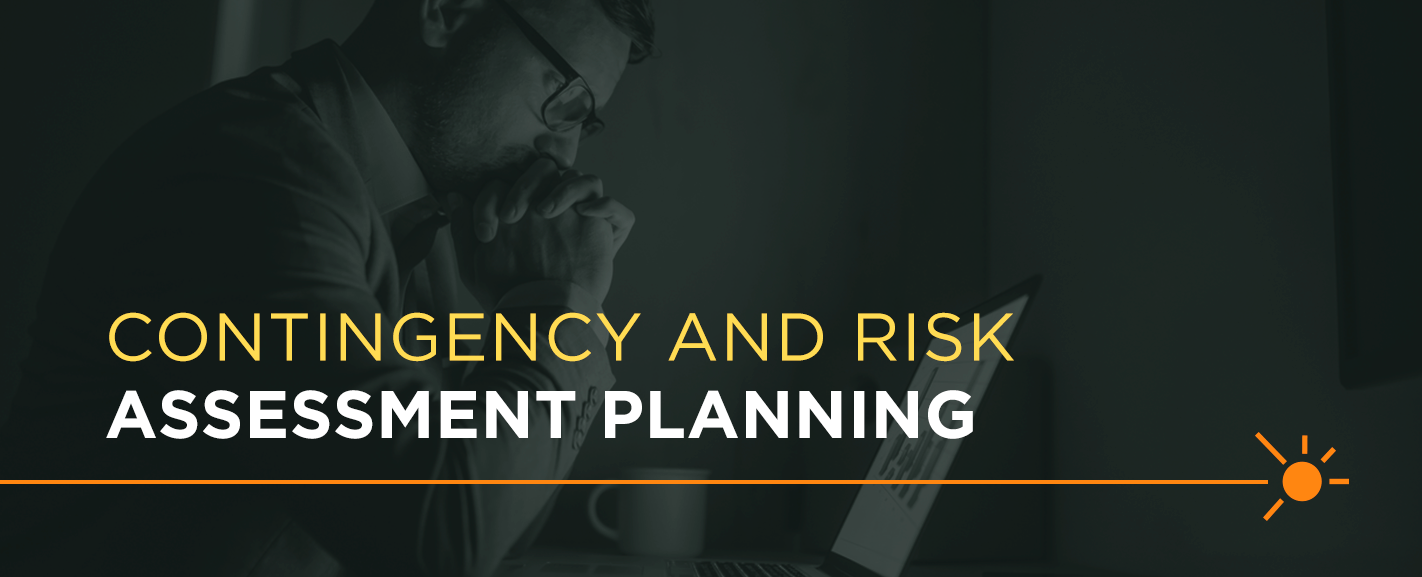
Emergency contingency planning is crucial to every business and facility. Disasters and emergencies can occur at any time, and without the proper safeguards in place, a company can sustain significant damage to its bottom line, workforce, and reputation. Conducting a risk assessment and creating response plans can be time-consuming and expensive when done alone. However, employing an experienced and successful company for contingency planning and risk management can make a considerable difference in your disaster mitigation efforts.
Here is some guidance on how to strategize for and protect against events that could disrupt your operations — plus how you can benefit from hiring an external party to handle your safety contingency plans and risk reports.
Jump to:
- Purpose of a Contingency and Risk Assessment Plan
- Types of Potential Emergencies
- Contingency Planning Services
- Emergency Preparedness Plan and Preparation
Purpose of a Risk Assessment and Contingency Plan in Risk Management
What is an emergency preparedness plan? It is a detailed strategy for protecting your business against external risks and emergencies, such as natural disasters. Creating a risk assessment plan and contingency report involves identifying the potential risk areas to create an effective response should those problems develop. These plans involve members on every level of an organization, from CEOs to entry-level employees, to inform these individuals of what to do in case of an emergency or impending event.
The essential steps to creating a contingency plan for risk management involve pinpointing what risks are most likely to disrupt your company — otherwise known as the risk assessment. Then, you must define how severe of an impact each of these risks will have and sort them into appropriate categories. Which ones will have the most devastating effects should they occur? These top priority concerns will require the most detailed action plans.
Once a business discovers what its risks are, it can go about addressing them in numerous ways. This stage is where you would begin building a contingency plan for how to approach the risk. How you respond will depend on multiple factors, such as how much risk your business is willing to take and what kind of risks you’re confronting. After you conduct emergency contingency planning and establish an effective set of methods, this strategy will need to be updated every year or so to ensure its timeliness and relevance.
Types of Potential Emergencies
Many types of emergencies can threaten a business, though we will primarily focus on two within this post — pandemics and natural disasters.
Pandemics
In the face of both pandemics and natural disasters, you should have an emergency preparedness plan for the workplace that includes protective actions for life safety, as defined by the Department of Homeland Security. These measures can include lockdowns, shelter-in-place orders, and evacuations — actions that are meant to protect the lives of every person within a facility.
Natural disasters happen quite frequently, especially depending on where your business is located, but you may have little experience with planning for a pandemic. The elements of a risk mitigation and response plan for a pandemic will include many of the same components you’d employ for other types of emergencies. Your risk assessment and contingency plan should contain an executive summary, stakeholder commentary, funding, and health safety information.
Every risk analysis — including pandemic-based plans — should merge the below concepts into a singular, detailed strategy for your business or facility to operate from:
- Design and engineering
- Procurement and construction management
- Cost estimating
- Identification of funding and regulatory limitations
- Master planning
- Maintenance planning
- Public discussion facilitation
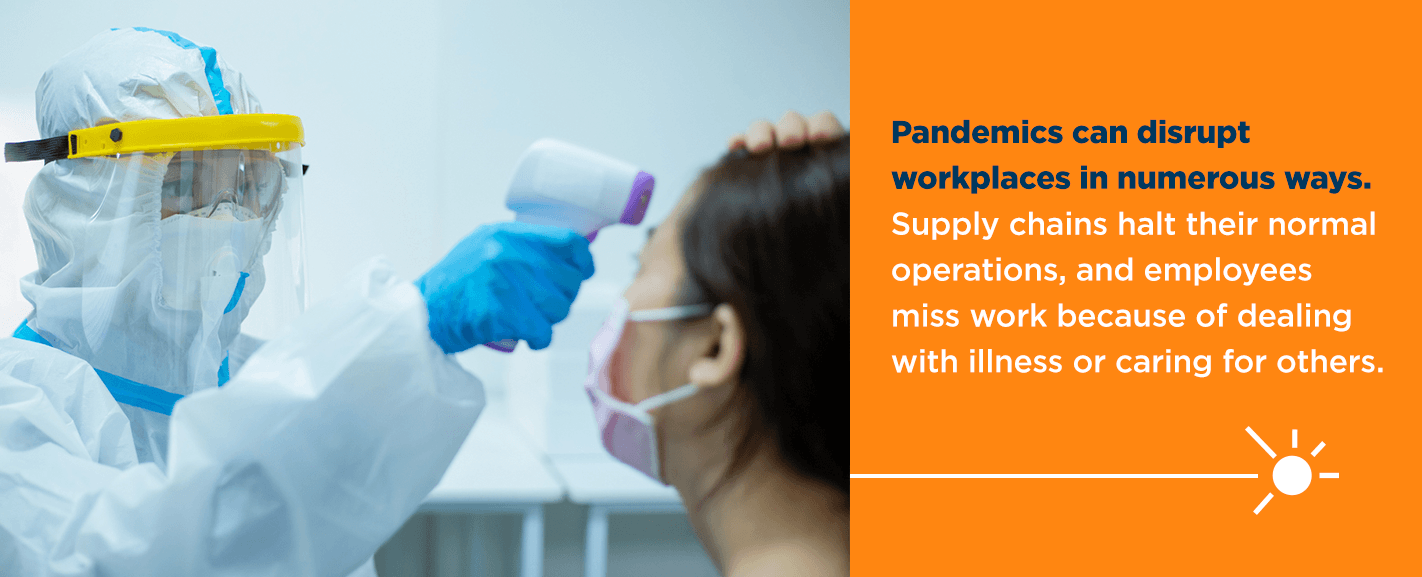
Pandemics can disrupt workplaces in numerous ways. Supply chains halt their normal operations, and employees miss work because of dealing with illness or caring for others. Pandemic planning addresses these issues while also considering the health and safety of everyone within your workplace or facility. Here are some best practices to keep in mind when strategizing for specific events like pandemics:
- Know the right information: Review local and federal health and safety guidelines to ensure your business is compliant with these measures. Train your employees on how to uphold these guidelines and any company-specific techniques you’re adopting to protect workers and clients.
- Create business and facility guidelines: Establish policies that will protect employee well-being, such as mental health initiatives and sick policies that avoid penalizing anyone who falls ill. Develop a social distancing plan that will enable your workers and consumers to interact without the risk of transmitting infection.
- Develop an essential team: It may be necessary to downsize your workforce and only maintain vital positions to avoid disease spread or prevent your business from falling into debt. In this case, it should be a priority to cross-train essential workers so they’ll be prepared for additional job duties.
- Gather supplies: Make sure you have enough cleaning supplies and items like hand sanitizer, soap, and personal protective equipment (PPE) for every person. Consider each item’s shelf life and recommended storage conditions to ensure your goods last for as long as possible.
- Identify risks with a risk report: Analyze your business or facility for potential health risks — do employees frequently interact with members of the public? In unprotected environments, it is more likely for someone to fall ill. Enforce social distancing and the necessary hygiene methods, but also be sure to work with your insurance company and local health agencies to provide your workers with medical care.
Natural Disasters
Natural disasters can come in the form of tornadoes, hurricanes, floods, earthquakes, and many more events. Each type of natural disaster requires its own emergency plan for optimal preparedness and disaster mitigation, as they all bring a unique set of circumstances. For example, you might find it necessary in your risk reports to invest in commercial flood insurance if your facility is located in an area that often experiences floods.
You can also sign up to receive alerts from your local community warning service or follow a federal service like the National Oceanic and Atmospheric Administration (NOAA) Weather Radio. You should create and regularly practice flash flood evacuation plans that include emergency functions and specific exit procedures. This natural disaster is only one example of the kind of planning you might do when facing a weather event. Familiarize yourself with the most common disasters and mitigation strategies in your region.
You can use a FEMA emergency preparedness plan to help you pinpoint specific risks and brainstorm actionable items for addressing these issues. FEMA categorizes disasters as recurring events consisting of four phases — although some businesses split them into five and alter the order of steps as necessary:
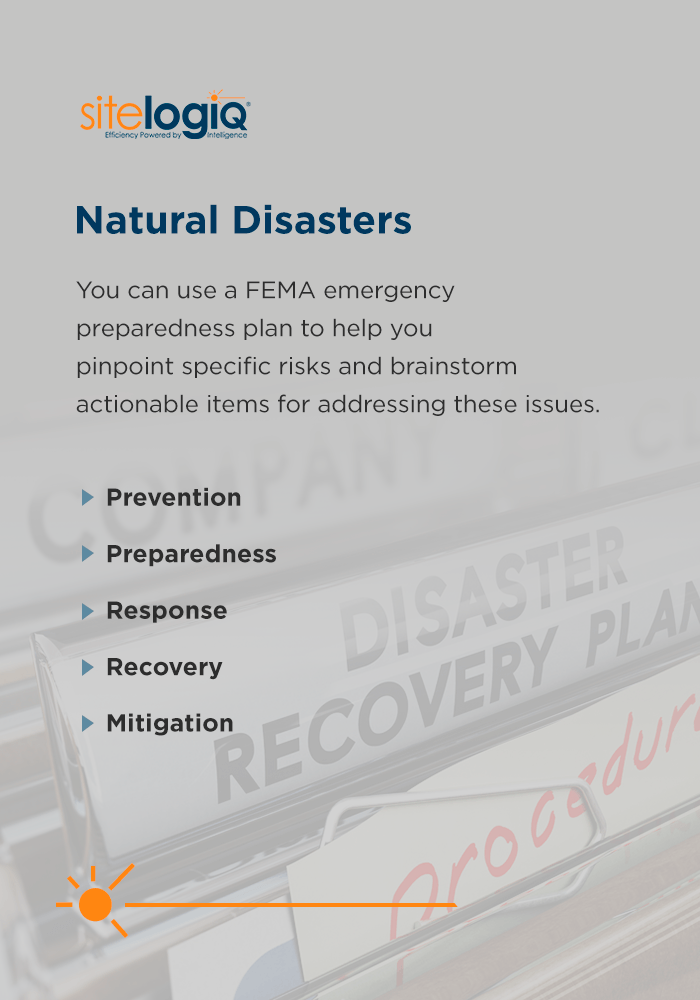
- Prevention: This phase involves many of the actions outlined in this article, such as preparing for disasters to reduce losses. Running risk analyses helps your business identify concerns and begin answering them. A planning team should be created with a representative from every department in your company to perform assessments.
- Preparedness: Preparedness prioritizes ongoing strategies such as employee training and emergency planning. Business leaders and workers must be able to recognize threats early on so they can respond accordingly. Emergency preparedness planning for disaster response should always account for human, business, and property impact.
- Response: The emergency procedures you establish determine how you respond to sudden risks. If your company’s supply chain faces significant downtime due to the wide-reaching effects of a natural disaster, how will you pivot to keep operations flowing efficiently?
- Recovery: The recovery phase involves the restoration of day-to-day services, allowing companies to return to normal operating procedures as soon as possible. This stage will often involve the use of post-emergency services and insurance policies, as well as your company’s legal team.
- Mitigation: Mitigation involves lessening the loss of life and assets. Through protecting employees and facilities, businesses can reduce the severity with which they’re affected by a natural disaster or other phenomena. This step can include restructuring emergency plans to better serve real-life scenarios and developing improvement strategies to address gaps in current plans.
SitelogIQ’s Contingency Planning Services
SitelogIQ offers a three-tiered contingency plan for businesses looking to protect their employees and their assets on a long-term scale, especially during these current uncertain times. Because no single solution can fit every business, we work with your company or facility to develop a plan that suits your specific needs.
Tier 1 — Engineered Infection Protection (EIP)
The first level of our multi-tier approach involves our pathogen mitigation plan, which helps you sanitize and restore your facility both now and in the long term. As a part of this tier, we offer deliverables such as an EIP Selection Matrix, which we build by visiting your facility and conducting engineering work. Other deliverables include a five-year, long-term facility maintenance tool with EIP measures and funding sources to keep your facility well-maintained long after the initial pandemic.
As an added option, you can load your five-year plan into our proprietary database using data entry only, which requires less effort and time. Adopting such a tool can help you manage committed costs and maintain your existing assets, keeping your building safe and energy-efficient. Your long term maintenance strategy can become part of a master plan intended to facilitate long-term upgrades and improvements within your business. Your master plan will share several common elements with your emergency preparedness and safety contingency strategy, including risk identification and mitigation.
Advantages of adopting EIP include:
- Low barrier to entry: There are no intricate or lengthy processes involved in using our planning services. By providing a low barrier to entry, we can get you started on emergency contingency planning quickly and easily.
- Trust building: Because we conduct every step of the process — humidification, filtration, ultraviolet germicidal irradiation (UVGI), and more — we keep ourselves transparent so you are always aware of the next steps.
- Custom solutions: Our surface and airborne contamination solutions can adjust to fit your facility and provide the most effective cleaning and decontaminating power for your needs. Cleaning technologies we use include electrostatic and ultra-low-volume (ULV) fogging and UVGI.
Tier 2 — Policy Implementation Plan
The second level of our approach includes implementing policies that will enable everyone in your workplace to have a standard protocol for pandemic management. This solution allows you to access deliverables such as color-coded floor plans to enforce social distancing and design documents for facility modifications. These modifications can apply to room layouts, improved protective measures for employee and visitor well-being, and many more safety features.
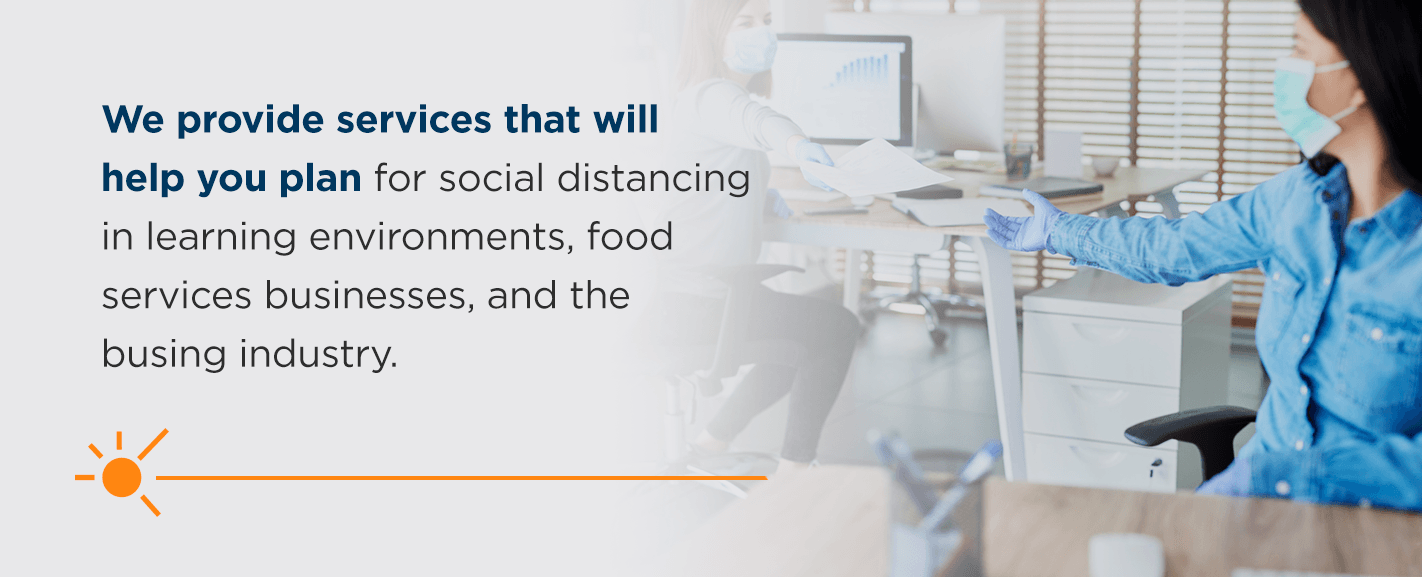
We provide services that will help you plan for social distancing in learning environments, food services businesses, and the busing industry. Whichever sector you’re part of, you can benefit from SitelogIQ’s plan. By choosing our policy implementation plan, you will also receive recommended architectural modifications and measures.
Tier 3 — Installation of Protective Measures
Once you have chosen your preferred protective measures, SitelogIQ will install these components. We use both GS schedules and external service providers (ESP) for procurement. When you choose our contingency planning services, you receive a customized plan that accounts for all local conditions, including:
- Signage and wayfinding plans
- Cost assessment
- Site, campus, and room plans
- Funding plans
- Procurement list
- Ramping and toggling plans
SitelogIQ offers multiple construction management solutions — Agency Construction Management, Construction Management At-Risk, and Program Management. Here’s a look at what each one offers during the building process:
- Agency Construction Management: This solution works as a fee-based service that provides you a highly experienced and objective advocate throughout the process. SitelogIQ serves as your Agency Construction Manager (ACM) by walking you through each step and taking every action within your best interest. Our in-house team offers numerous high-quality services for each phase — preconstruction, construction, and close-out.
- Construction Management At-Risk: When you choose this solution, SitelogIQ will work with you as the Construction Management At-Risk Provider during the preconstruction phase. You’ll receive services such as cash flow analysis, value engineering, and scheduling. Once things move into the construction phase, we continue conducting the building process until completion.
- Program Management: SitelogIQ manages the entire project team, including the design team and other vital members, to help you organize your system under a single entity. We hire your architects, engineers, and other contractors and perform contract administration with everyone on your team. By choosing program management, you can increase your operational efficiency and eliminate high contingency expenses.
Let SitelogIQ Coordinate Your Emergency Preparedness Plan and Preparation
If you need assistance with conducting a business risk analysis and creating a contingency plan customized for your local conditions, SitelogIQ will guide you through every step of the process. We are a full-service facility planning, design, and management company with expert-level knowledge in facility maintenance and construction. Our team consists of architects, energy managers, engineers, and many more individuals with extensive experience in facility creation and upkeep.
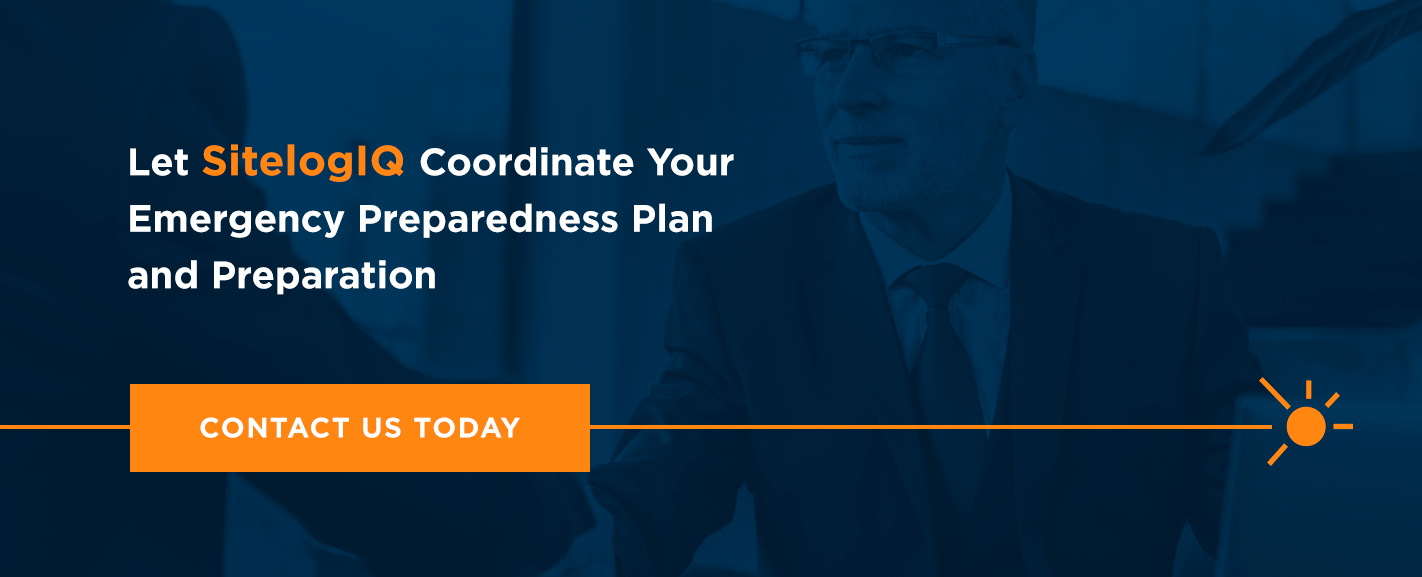
Our experience with facilities in various disciplines — including healthcare, education, government, and more — ensures we will deliver a customized and efficient project no matter what kind of facility you own. Learn how to manage pandemics, natural disasters, and other types of emergencies more effectively by getting in touch with us today. Call us at 888.819.0041 or fill out our contact form for more information.


